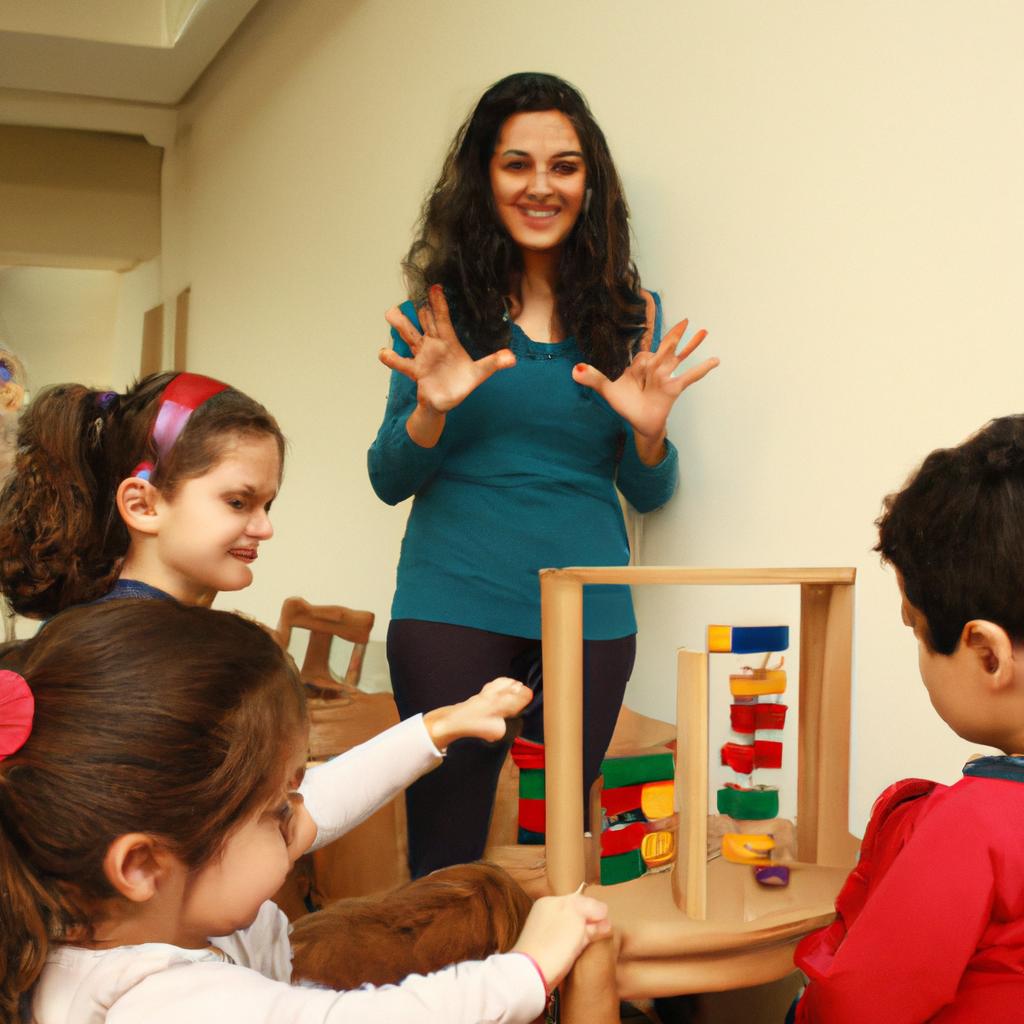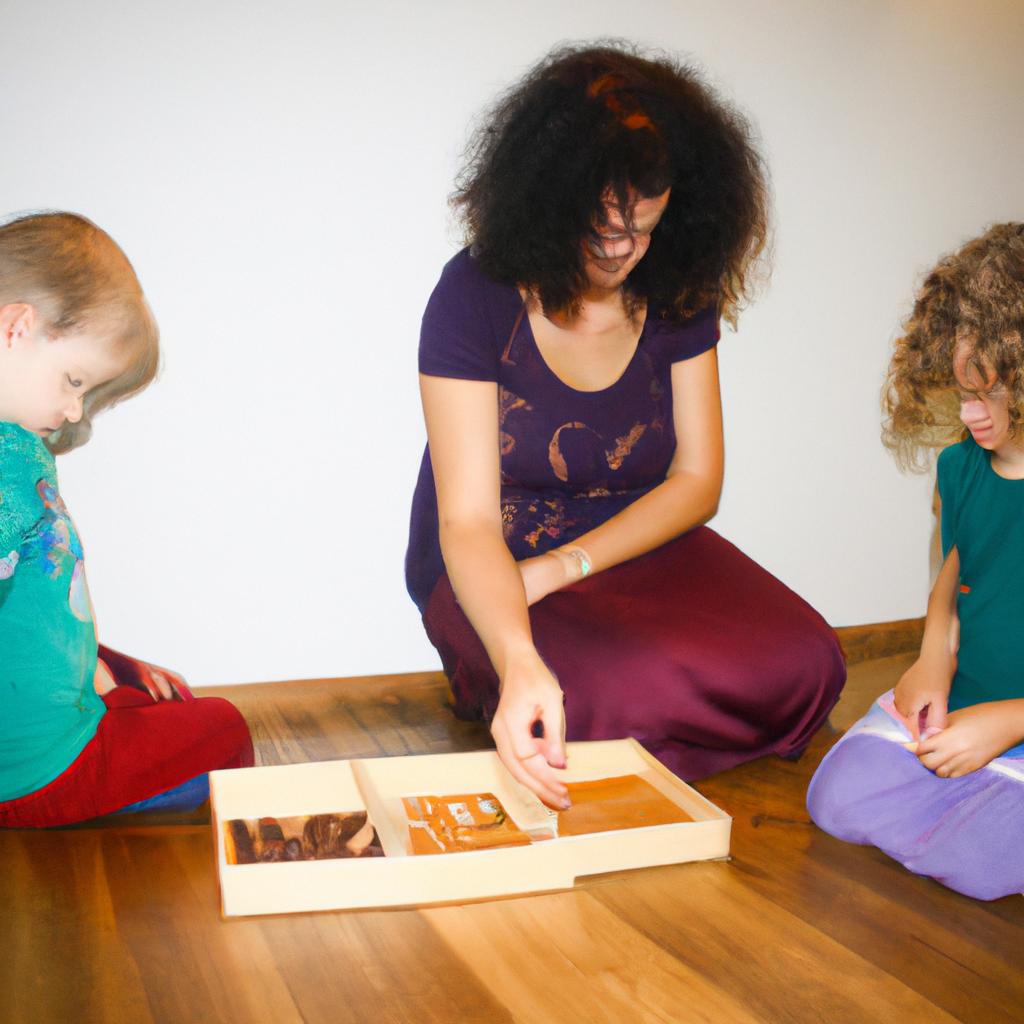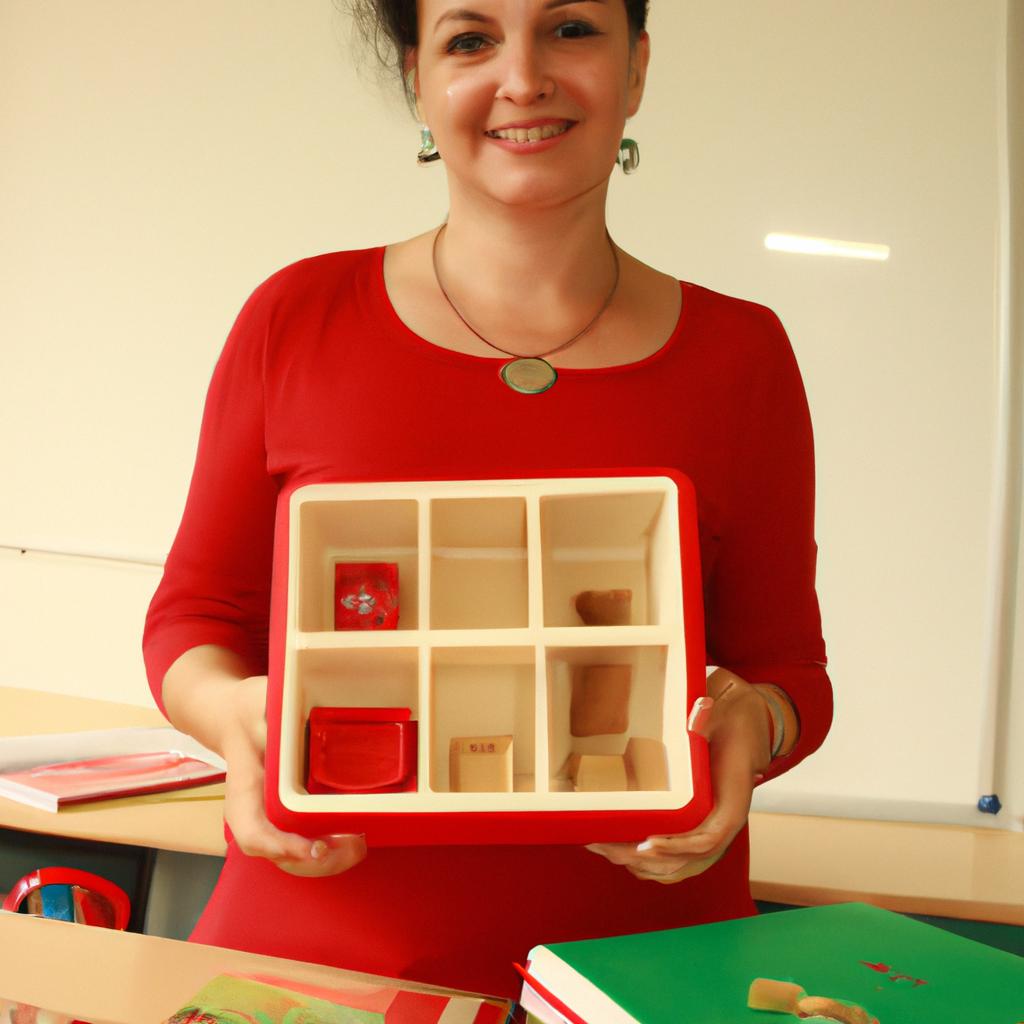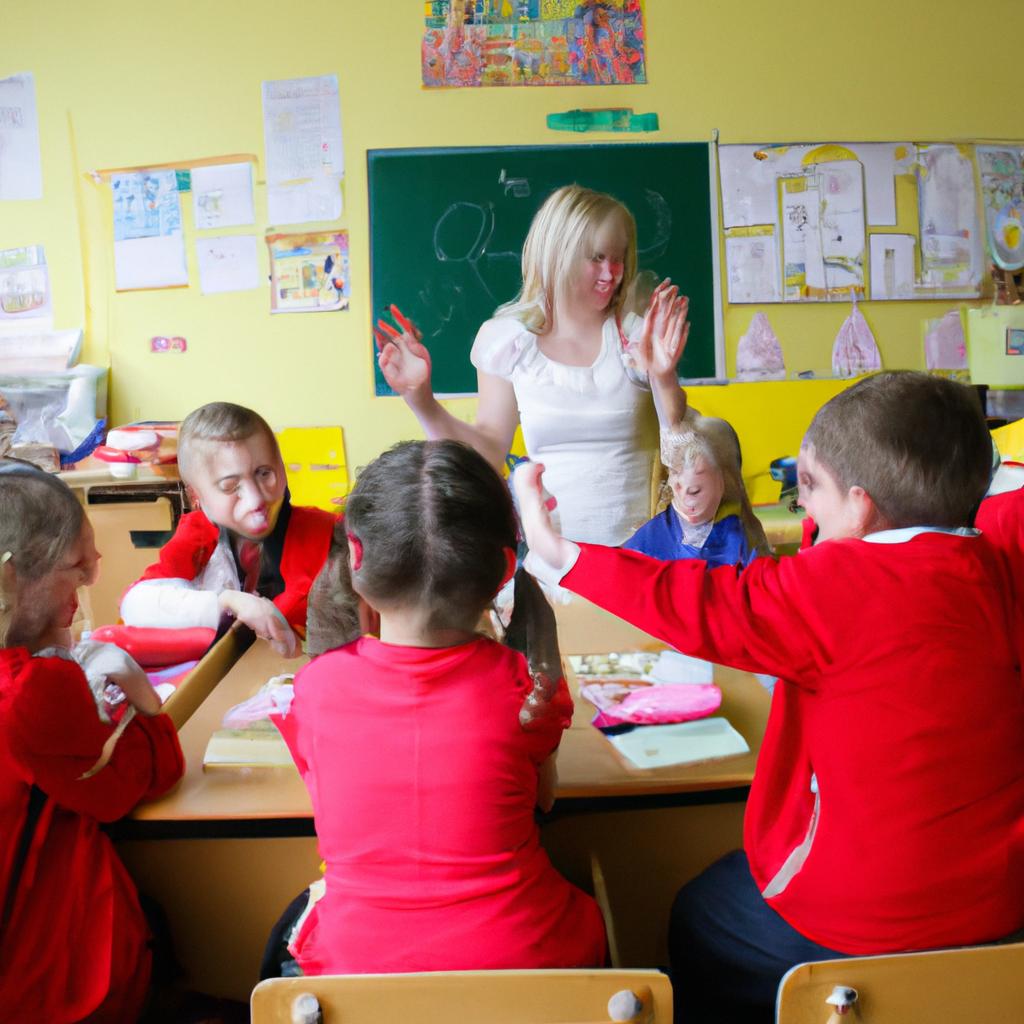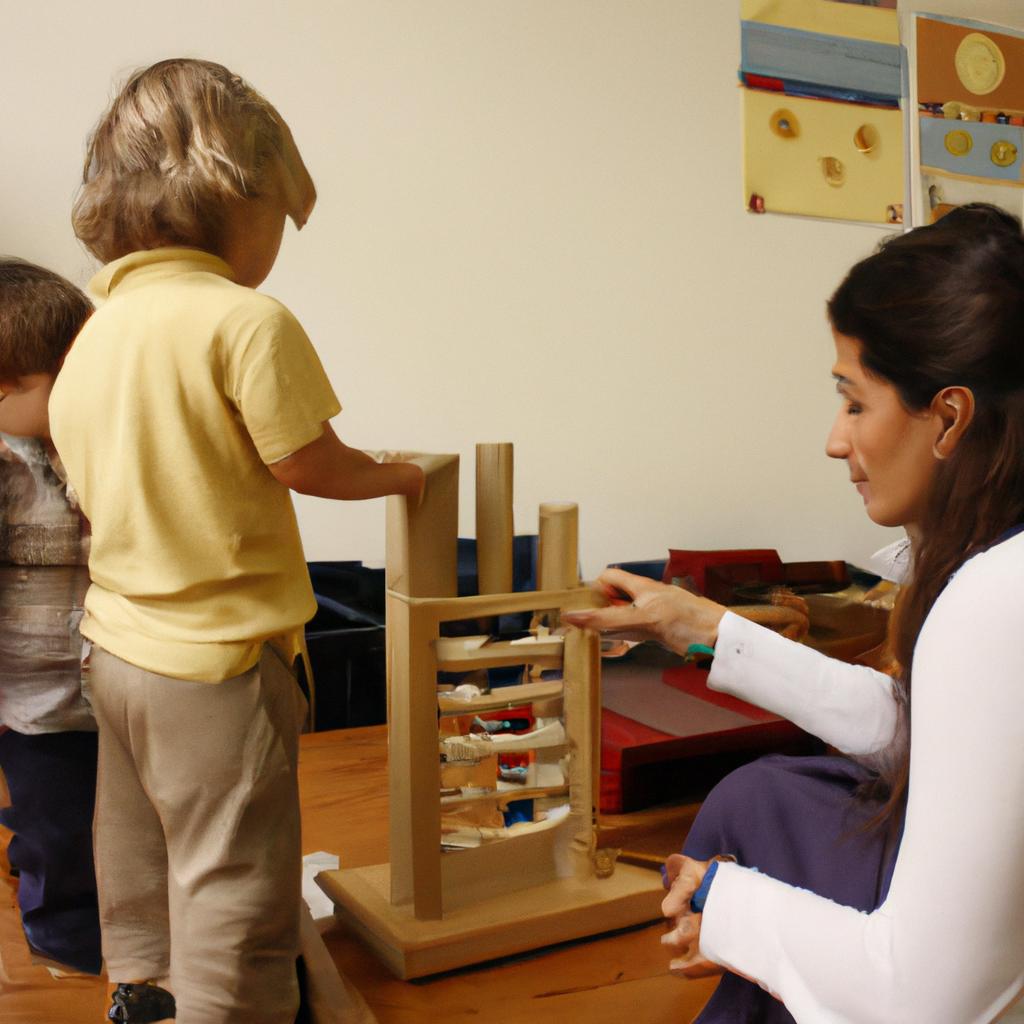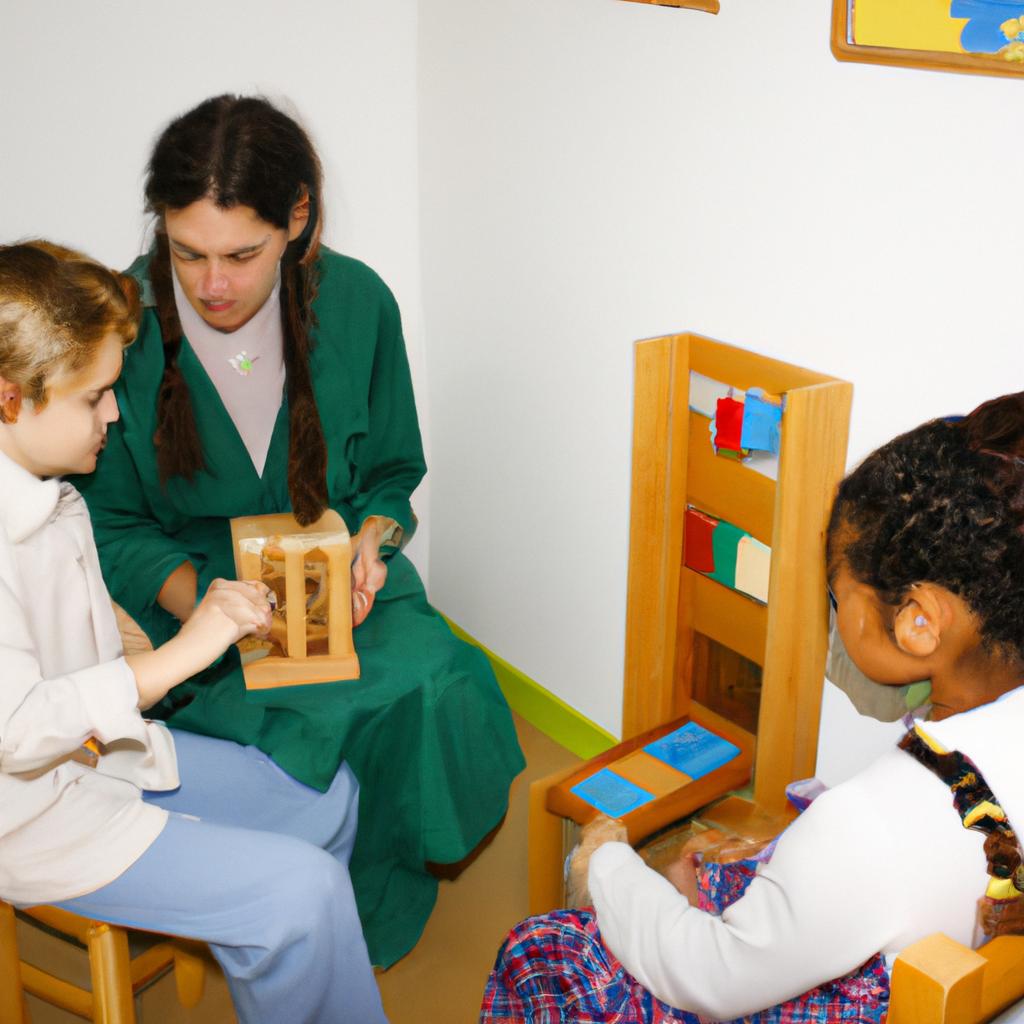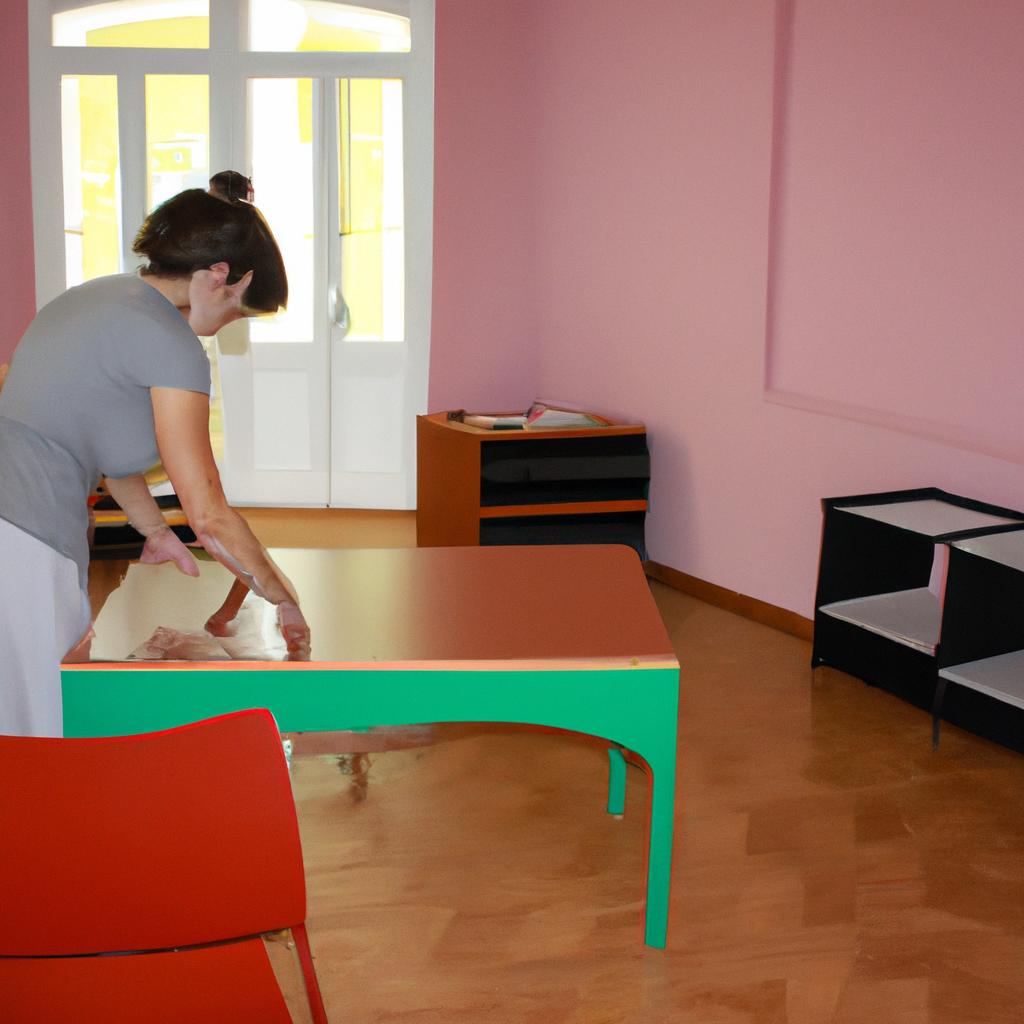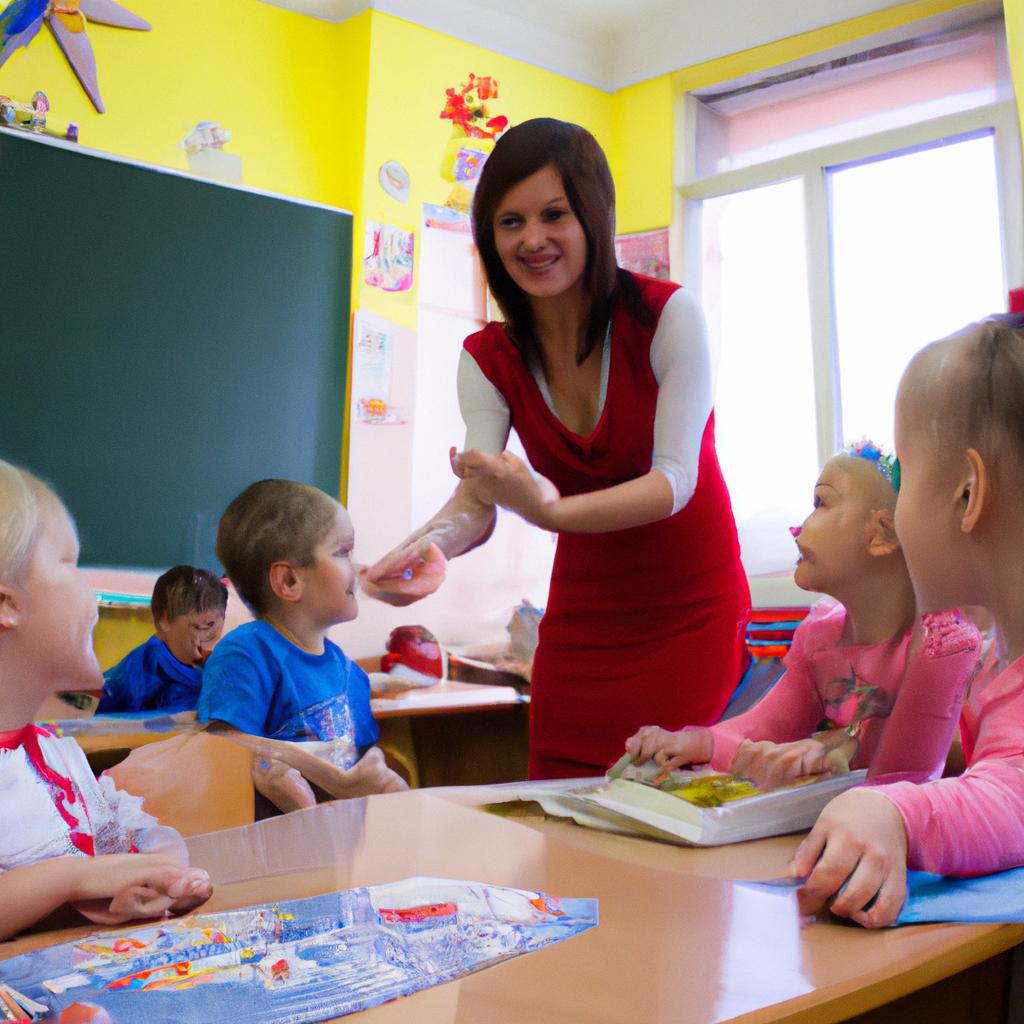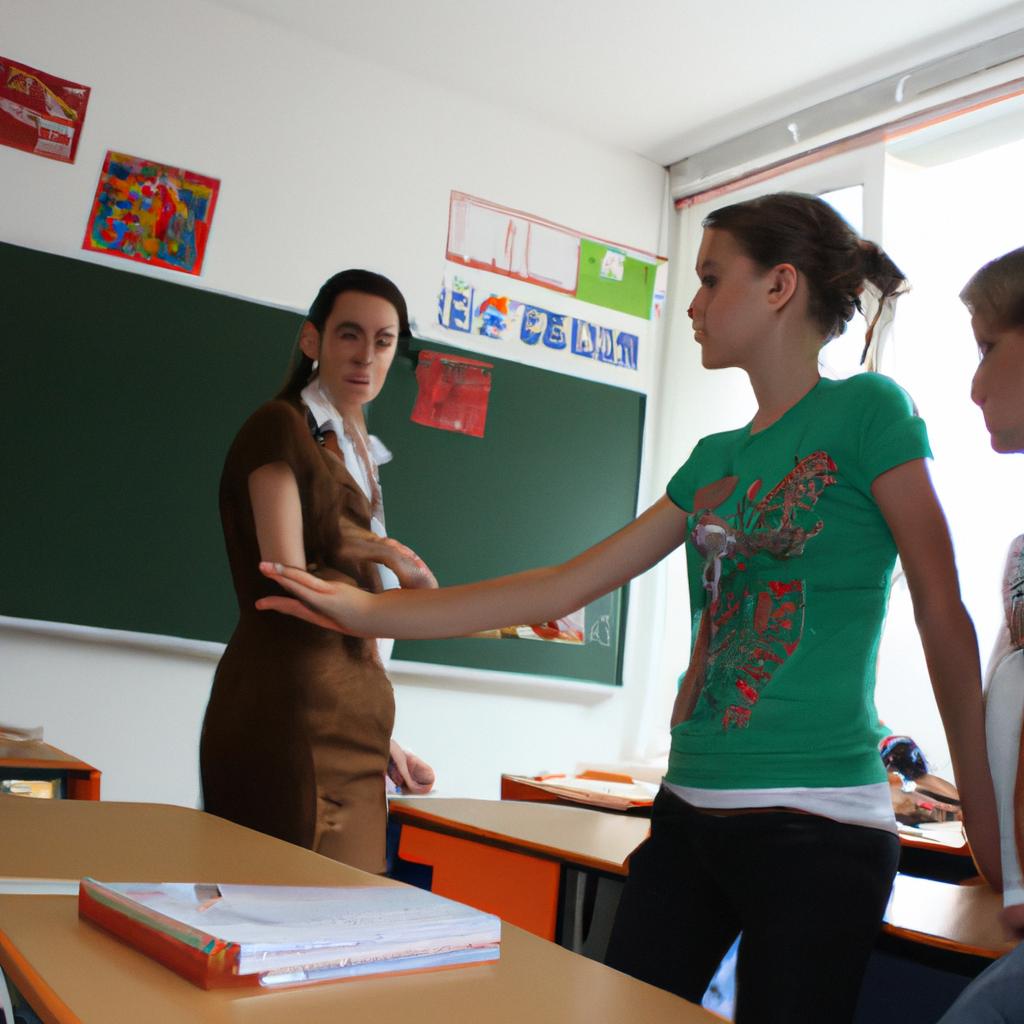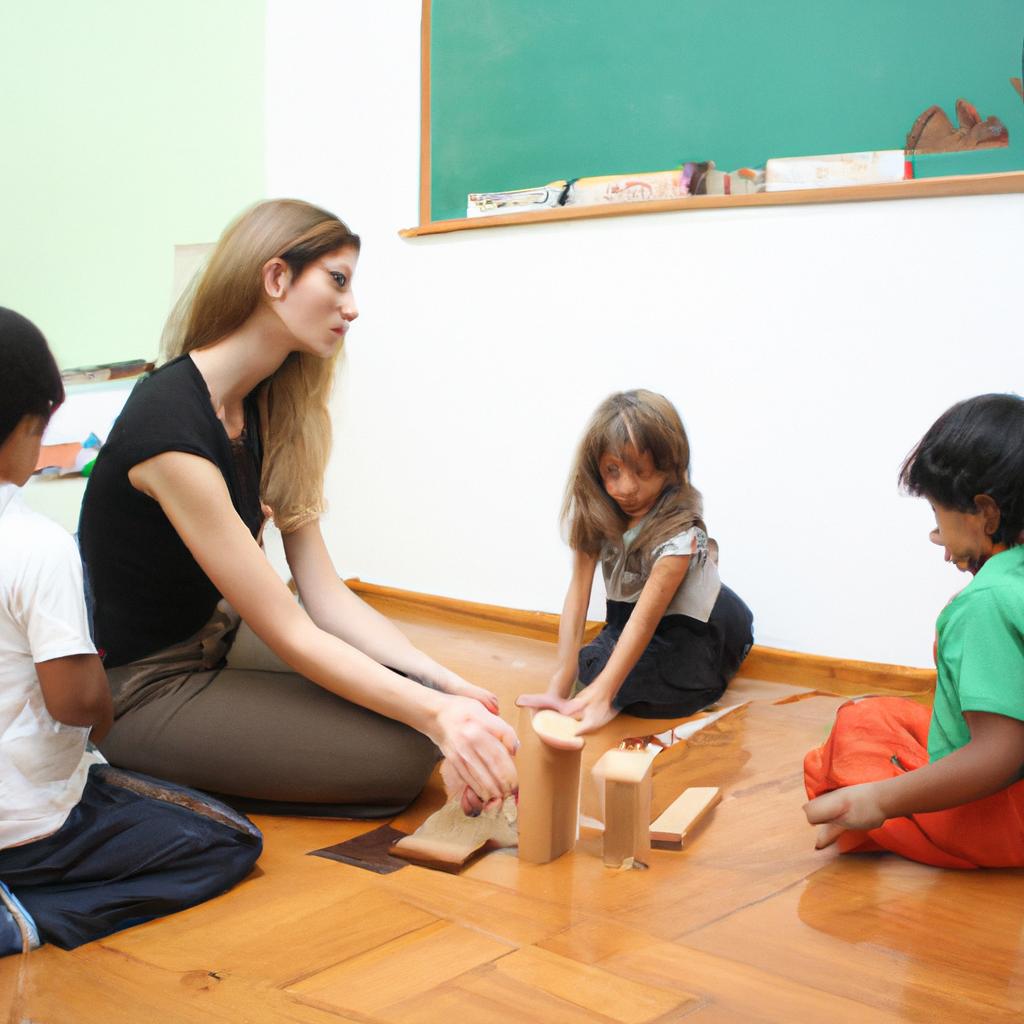The Montessori philosophy is a holistic educational approach that focuses on the development of children’s independence, self-discipline, and love for learning. This article aims to explore the key elements of the Montessori school system, including its unique materials and curriculum. By examining the principles behind this method and showcasing an example of its implementation in practice, readers will gain a deeper understanding of how the Montessori philosophy can shape young minds.
Imagine a classroom where students are not confined to desks but instead have freedom to move around and choose their own activities. Such is the case in a Montessori school, where children are encouraged to actively engage in hands-on learning experiences. The Montessori materials play a vital role in this process as they provide concrete representations of abstract concepts. From sensory objects like sandpaper letters to math manipulatives such as golden beads, these carefully designed materials stimulate exploration and promote independent thinking among students. Moreover, the Montessori curriculum embraces individualized instruction tailored to each child’s unique needs and interests.
Understanding the Montessori Philosophy
Imagine a classroom where young children are free to explore, discover, and learn at their own pace. This is the essence of the Montessori philosophy, an educational approach developed by Dr. Maria Montessori in the early 20th century. In this section, we will delve into the key principles that underpin this unique pedagogy.
Central to the Montessori method is the belief that each child has an innate desire to learn and grow. By creating an environment that fosters independence and self-directed learning, educators aim to nurture this natural curiosity. Instead of following a rigid curriculum dictated by a teacher, students have the freedom to choose from a wide range of materials and activities specifically designed to meet their developmental needs.
A hallmark of Montessori education is its emphasis on hands-on learning. Students engage with manipulative materials carefully selected for their ability to promote sensory exploration and cognitive development. Take, for example, the pink tower—a set of ten graduated cubes used to teach concepts such as size discrimination and spatial awareness. Through repeated use of these tangible tools, children develop not only academic skills but also fine motor coordination and concentration abilities.
To better understand how the Montessori philosophy impacts student learning outcomes, consider some emotional responses it evokes:
- A sense of wonder: witnessing children actively engaged in purposeful work sparks awe and appreciation for their capacity for growth.
- Empowerment: observing youngsters taking charge of their learning journey instills confidence and inspires others to do the same.
- Resilience: seeing children make mistakes and persevere through challenges cultivates a spirit of resilience that extends beyond academia.
- Community building: noticing collaborative efforts among students encourages empathy, cooperation, and respect for one another.
In addition to these emotional responses, let’s take a closer look at how different aspects of the Montessori philosophy align with its overarching principles:
| Principle | Aspect | Alignment |
|---|---|---|
| Individualized learning | Self-paced curriculum | Acknowledges and respects each child’s unique development timeline. |
| Prepared environment | Montessori materials | Offers a rich, purposeful setting that supports exploration and independent discovery. |
| Freedom within limits | Structured choice of activities | Encourages decision-making skills while providing necessary boundaries for safety and order. |
| Role of the teacher | Facilitator and guide | Guides students’ progress, observes their interests, and offers appropriate guidance when needed. |
As we delve deeper into the role of the Montessori school in education, it becomes evident how the philosophy translates into practical applications. By recognizing children as active participants in their own learning process and providing them with tools for self-directed exploration, Montessori schools empower young learners to become confident, capable individuals ready to embrace future educational challenges.
The Role of the Montessori School in Education
Exploring Montessori School, Materials, and Curriculum
Understanding the Montessori philosophy provides a solid foundation for comprehending the inner workings of a Montessori school. Let’s delve deeper into this unique educational approach by examining its practical applications in real-life scenarios.
Consider the case study of Emily, a five-year-old student attending a Montessori school. In her classroom, she is given the freedom to choose activities that spark her interest and engage her curiosity. Unlike traditional classrooms where students follow a predetermined curriculum, Emily has the autonomy to explore various subjects at her own pace. For instance, if she shows an affinity for mathematics, she can spend more time working with math materials such as counting beads or number rods. This personalized learning experience fosters independence and self-motivation in children like Emily.
To further illustrate the impact of Montessori education, let us examine some key features commonly found in Montessori schools:
-
Mixed-age classrooms: Instead of grouping children based on their chronological age, Montessori classrooms typically consist of mixed-age groups spanning three years (e.g., ages 3-6). This structure encourages collaboration among peers and allows younger students to learn from older ones.
-
Prepared environments: A hallmark of the Montessori method is the carefully curated environment designed to facilitate independent exploration and learning. The classroom is filled with hands-on materials meticulously arranged on low shelves within reach of children. These materials are specifically crafted to promote sensory development, mathematical understanding, language acquisition, and other essential skills.
-
Uninterrupted work periods: In contrast to conventional schooling models characterized by frequent transitions between subjects and rigid schedules, Montessori schools emphasize uninterrupted work periods. During these extended blocks of time, students have the freedom to immerse themselves fully in their chosen activities without interruption or external pressures.
By incorporating these elements into daily practices and routines, Montessori schools create an optimal setting for fostering holistic development and a lifelong love for learning.
As we explore the benefits of Montessori education in the subsequent section, it becomes evident that this educational approach not only nurtures academic growth but also promotes social-emotional well-being. Let’s delve deeper into how children thrive within Montessori environments and discover why this philosophy continues to captivate educators worldwide.
Benefits of Montessori Education
Building upon our understanding of the Montessori philosophy, let us now delve into the crucial role that Montessori schools play in education. To illustrate this, consider a hypothetical scenario where a child named Emma enters a Montessori school at the age of three.
Paragraph 1:
Upon entering the Montessori environment, Emma is introduced to an educational setting that values independence and self-directed learning. At her own pace, she starts exploring various materials and activities provided by the school. These materials are carefully designed to foster cognitive development and promote hands-on experiential learning. For instance, Emma may come across the practical life area, where she learns skills such as pouring water or arranging flowers. This helps her develop fine motor skills while also fostering concentration and focus.
Paragraph 2:
In addition to offering a supportive environment for individual growth, Montessori schools emphasize social interactions among children from diverse backgrounds. Through mixed-age classrooms, older students serve as mentors for younger ones, creating opportunities for collaboration and peer learning. This not only cultivates empathy but also nurtures leadership qualities among older children like responsibility and patience. Moreover, the absence of traditional grades allows each child’s progress to be assessed holistically rather than through comparative measures.
- Empowers children to become active learners
- Encourages creativity and critical thinking
- Fosters a love for lifelong learning
- Promotes holistic development
Paragraph 3:
Montessori schools go beyond merely imparting academic knowledge – they strive to create well-rounded individuals who possess essential life skills alongside intellectual abilities. By integrating subjects seamlessly within interdisciplinary projects, these institutions equip students with problem-solving capabilities that extend far beyond textbooks. As Emma progresses through her years in the Montessori system, she develops resilience and adaptability while gaining confidence in her ability to explore new ideas and embrace challenges.
| Benefits of Montessori Education |
|---|
| Encourages independent thinking |
| Develops self-discipline |
| Cultivates a love for learning |
| Nurtures social-emotional growth |
Understanding the pivotal role that Montessori schools play in shaping an individual’s educational journey lays the foundation for exploring another vital aspect: the significance of Montessori materials. By providing hands-on learning experiences, these carefully crafted tools contribute significantly to children’s development and understanding within the Montessori framework.
The Importance of Montessori Materials
Building on the understanding of the benefits of Montessori education, it is equally important to explore the significance of Montessori materials in facilitating effective learning experiences. These carefully designed educational tools play a crucial role in supporting children’s development and fostering independent exploration within a Montessori classroom.
Montessori materials are specifically crafted to promote hands-on engagement and encourage active learning among students. For instance, consider a hypothetical case study where a child is introduced to the Montessori material known as the Pink Tower. This set consists of ten pink wooden cubes varying in size from 1 centimeter cubed to 10 centimeters cubed. Through this material, children not only learn concepts such as spatial awareness and mathematical relationships but also develop fine motor skills by stacking and manipulating each cube with precision.
To better understand the impact of Montessori materials, let us delve into four key aspects that highlight their importance:
- Sensorial Development: The use of sensorial materials allows children to engage their senses while exploring various concepts such as color, shape, texture, weight, and more. By employing these materials, children enhance their ability to observe, discriminate between different attributes, and make connections between abstract ideas and concrete representations.
- Independence: Montessori materials facilitate self-directed learning by providing clear guidelines for usage. With minimal adult intervention, students can independently choose and work with appropriate materials based on their interests and abilities. This autonomy fosters a sense of responsibility and instills confidence in young learners.
- Sequential Learning: The progression of Montessori materials follows a logical sequence that builds upon previously acquired knowledge. Each material introduces new challenges while incorporating previously learned concepts. This sequential approach ensures a solid foundation before moving onto more complex topics.
- Concrete Understanding: Through hands-on interaction with specially designed materials, students develop an understanding grounded in real-world experiences rather than relying solely on abstract concepts or rote memorization. This tangible connection aids in the internalization of knowledge and promotes deeper understanding.
| Montessori Material | Purpose |
|---|---|
| Pink Tower | Develops spatial awareness and fine motor skills. |
| Number Rods | Introduces concepts of quantity, length, and numerical relationships. |
| Cylinder Blocks | Enhances visual discrimination, coordination, and problem-solving abilities. |
| Botany Cabinet | Encourages exploration of plant life through classification and identification. |
As we delve into exploring the Montessori curriculum further, it becomes evident that these materials serve as vital tools for facilitating holistic learning experiences within a Montessori setting. By harnessing their sensorial nature, promoting independence, following a sequential approach, and fostering concrete understanding, these materials lay the groundwork for children’s academic growth while nurturing their overall development.
Understanding the importance of Montessori materials enables us to appreciate how they synergize with the carefully crafted curriculum to create an enriching educational environment for young learners. Let us now explore the components of the Montessori curriculum in greater detail.
Exploring the Montessori Curriculum
Building on the foundation of Montessori materials, let’s now explore the comprehensive curriculum that is an integral part of a Montessori education.
The Montessori curriculum encompasses a wide range of subjects and activities designed to promote holistic development in children. One example is the Language Arts area, where students are immersed in language-rich environments that foster reading, writing, speaking, and listening skills. For instance, imagine a child named Emma who enters a Montessori classroom with limited English proficiency. Through engaging activities like phonetic word building using movable alphabets and storytelling circles, Emma gradually develops her language skills while gaining confidence in expressing herself.
To better understand how the Montessori curriculum addresses different aspects of a child’s development, consider these emotional responses evoked by its key features:
- Independence: The emphasis on independence instills a sense of self-confidence as children learn to make choices and take responsibility for their own learning.
- Individualized Learning: Each child receives personalized attention from educators who observe their unique strengths and challenges, allowing for tailored instruction.
- Hands-On Exploration: By providing concrete materials and hands-on experiences, the Montessori approach stimulates curiosity and active engagement in learning.
- Collaborative Environment: Peer interaction plays a crucial role in fostering social skills such as empathy and cooperation within the Montessori community.
Furthermore, this table highlights some key areas covered by the Montessori curriculum:
| Subject | Key Focus | Benefits |
|---|---|---|
| Mathematics | Concrete concepts | Problem-solving abilities |
| Science | Inquiry-based | Critical thinking skills |
| Cultural Studies | Global perspectives | Respect for diversity |
| Practical Life | Everyday tasks | Fine motor skill development |
In summary, the Montessori curriculum goes beyond traditional academic content; it aims to nurture well-rounded individuals by encompassing various domains of development. By fostering independence, providing individualized learning opportunities, promoting hands-on exploration, and creating a collaborative environment, the Montessori approach cultivates engaged learners who are prepared to excel academically and thrive socially.
As we delve deeper into understanding Montessori principles, let’s now explore how these philosophies can be implemented at home in order to support your child’s educational journey.
Implementing Montessori Principles at Home
Transitioning from our exploration of the Montessori curriculum, we now turn our attention towards gaining a deeper understanding of Montessori schools, materials, and how they collectively contribute to the unique educational experience. To illustrate this further, let us consider an example where a child named Emma is enrolled in a Montessori school.
Montessori schools are characterized by their emphasis on child-led learning and fostering independence. In these environments, children like Emma have the freedom to choose activities that align with their interests and developmental needs. The classroom is carefully designed to provide various hands-on materials that cater to different areas of development such as language skills, sensory perception, mathematics, practical life tasks, and cultural studies.
The materials used in Montessori classrooms play a crucial role in facilitating self-directed learning. For instance, suppose Emma selects an activity focused on developing fine motor skills. She might come across a tray containing small objects that require her to use tweezers for precise manipulation. This exercise not only enhances her dexterity but also fosters concentration and problem-solving abilities. By working with such materials independently or collaboratively with peers under the guidance of trained Montessori teachers, children gain essential skills while actively engaging in meaningful learning experiences.
To better understand the significance of Montessori teaching methods and materials within a broader context, let’s examine some key elements:
- Child-centered approach: Unlike traditional education systems where teachers impart information through lectures, Montessori educators act as facilitators who observe individual students closely and guide them based on their specific needs.
- Focus on intrinsic motivation: Rather than relying solely on external rewards or punishments to motivate behavior and academic progress, Montessori philosophy encourages natural curiosity and love for learning.
- Mixed-age classrooms: Within a single classroom setting spanning multiple years (e.g., ages 3-6), older students serve as mentors to younger ones, fostering cooperation, empathy, and a sense of community.
- Emphasis on holistic development: Montessori education nurtures the intellectual, emotional, physical, and social growth of children. The curriculum seamlessly integrates subjects and promotes connections between different areas of knowledge.
| Developmental Area | Traditional Education Approach | Montessori Education Approach |
|---|---|---|
| Language Skills | Focused on rote memorization | Encourages self-expression through hands-on activities and storytelling |
| Math Concepts | Primarily textbook-based | Utilizes concrete materials for better conceptual understanding |
| Social Skills | Limited interaction opportunities during class time | Promotes collaboration among peers and teaches conflict resolution skills |
| Independence | Relies heavily on teacher guidance | Cultivates self-reliance and decision-making abilities |
In summary, Montessori schools create an environment that supports individualized learning experiences by incorporating specially designed materials into their curriculum. These materials not only facilitate academic progress but also promote essential life skills such as problem-solving, concentration, independence, and social interactions. By embracing a child-centered approach rooted in intrinsic motivation and emphasizing holistic development, Montessori philosophy continues to shape the educational landscape with its unique principles.
Through our exploration thus far, we have gained valuable insights into the core components of Montessori education. In our next section, we will delve into practical strategies for implementing Montessori principles at home – allowing parents or guardians to extend these transformative practices beyond school walls.

